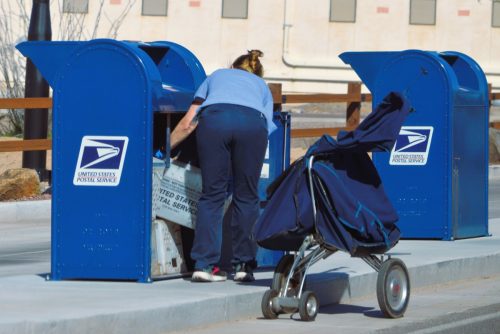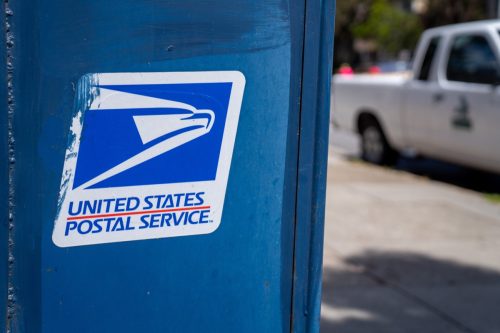Postmaster General Says He's Doing All He Can to Stop Mail Theft—But Officers Disagree
Some say the USPS is not utilizing all the tools it can to help protect postal operations.

Many of us put a lot of trust in the U.S. Postal Service (USPS). From financial checks to prescription medications, we expect the agency to safeguard some really important things while they're in transit to our home. Yet in reality, mail theft has become a major problem across the U.S. recently—so much so that even the USPS itself has acknowledged the significant surge and announced new plans to help prevent it. With these latest measures, Postmaster General Louis DeJoy has ensured customers that he's doing all he can to stop mail theft. But not everyone seems to agree. Read on to find out why postal officers are battling DeJoy over this prevalent problem.
READ THIS NEXT: USPS Warns "Mail Service Could Be Halted"—Even If You're Following the Rules.
Mail theft has become more prevalent.

The safety of your mail is at an all time low right now. In a May 12 press release, the Postal Service said that "attacks on letter carriers and mail fraud incidents have escalated concurrently with a national rise in crime." According to the agency, 412 USPS carriers were robbed while on the job during the last fiscal year. Meanwhile, there have already been 305 carrier robberies reported in just the first half of the fiscal year 2023.
The USPS said they've also seen "an increase in high volume mail theft incidents from mail receptacles including blue collection boxes" recently. In the 2022 fiscal year, there were a total of 38,500 reported cases of stolen mail. And there have already been more than 25,000 mail theft incidents reported in the first half of this year, according to the release.
The USPS recently expanded efforts to prevent this.

As a result of the recent rise, the Postal Service explained in its release that it is cracking down on mail theft with new prevention measures. "We're doubling down on our efforts to protect our Postal employees and the security of the mail. We are hardening targets—both physical and digital—to make them less desirable to thieves and working with our law enforcement partners to bring perpetrators to justice," Gary Barksdale, chief of the agency's Postal Inspection Service (USPIS), said in a statement.
The USPS and the USPIS are expanding efforts through their joint Project Safe Delivery crime prevention initiative to protect carriers, enforce legal measures against thieves, and prevent both mail and package theft. Some of the newly announced actions include replacing 12,000 blue collection mailboxes with high security boxes, and swapping 49,000 manual arrow locks with electronic versions.
"As crime rises, so do the threats against our public servants," DeJoy said in a May statement. "The men and women of the Postal Service are walking our nation's streets every day to fulfill our mission of delivering mail and packages to the American people. Every Postal employee deserves to work in safety and to be free from targeting by criminals seeking to access the public's mail."
RELATED: For more up-to-date information, sign up for our daily newsletter.
But some officials say the agency is failing to utilize certain tools.

These expanded efforts aren't good enough in everyone's eyes. During a May 17 House Government and Accountability subcommittee hearing, Rep. Jamie Raskin slammed DeJoy's new plan to crack down on mail theft because it is "very light on proactive protection for letter carriers," The Washington Post reported. According to the newspaper, Raskin accused the Postal Service of preventing "Postal Police Officers (PPOs) from doing their job" by not allowing them to protect carriers while they deliver mail.
But DeJoy claimed that this is not the case. "I don't have the authority to patrol the streets," he told Raskin. "And they haven't done that in the past … We don't have the legal authority to do that."
In response, Frank Albergo, president of the Postal Police Officers Association, told The Washington Post that the Postmaster General is "grossly misinformed" about this. "DeJoy is flat out wrong when he claimed PPOs have not conducted carrier protection and mail theft patrols," Albergo said, citing several documents indicating incidents where postal officers have gone out to protect carriers on the streets.
DeJoy still maintains that he is doing all he can.

When asked about the documented practice of postal street patrols in the past, DeJoy told The Washington Post that this doesn't give the agency the green light to continue allowing unauthorized behavior. "The Postal Service must always adhere strictly to actions they have the statutory authority to perform," he said. "Past failures to adhere to that limited authority must not be a justification for continuing to do so."
To back up DeJoy, USPS spokesman David A. Partenheimer pointed to a 2020 federal court decision that dismissed a union lawsuit against the agency for restricting police officers' jurisdiction. But Albergo noted that the court's ruling also stated that management could "leave the question of PPOs' off-premises policing authority to USPS's discretion," which means DeJoy could deploy PPOs to do street patrols if he wanted to, The Washington Post explained.
But the Postmaster General told Raskin that even if he wanted to, the USPS doesn't have enough cops to protect carriers out on the streets. "If I had 60,000 of them, I would come to you and ask for the authority," DeJoy said. "I don't. I have 600 and I don't have the authority to patrol the streets."





















